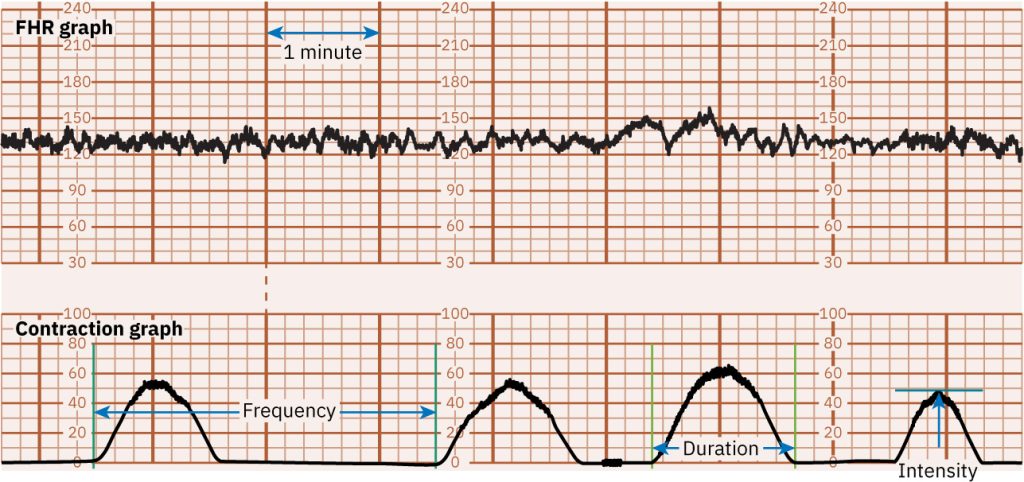10.13 Learning Activities
Learning Activities
Answers to case studies & questions are found in the Answer Key. Answers to the interactive elements are located within the element
Unfolding Labor & Delivery Case Study[1]
Situation/Background
Denise, a 38-year-old married woman and mother of three children, presents to the birthing unit. You are the labor triage nurse and will assess her on admission. She is G4 P3 T2 AB0 L3. Her children are ages 10, 4, and 2. She has a history of two previous vaginal deliveries, and her last delivery two years ago was a preterm cesarean birth for fetal distress. The infant was born at 32 weeks’ gestation. She hopes to deliver vaginally with the pregnancy. She had a reactive non-stress three days ago. Menses was regular and her last menstrual period was August 19.
Assessment Data
Physical examination findings: height: 65″, weight: 230 pounds, body mass index (BMI): 30, blood pressure: 130/92 mm Hg. She presents to the birthing unit because she thinks she is in labor. She is 40 weeks’ gestation and was dilated 1 cm/50% effaced and -2 station at her last visit. The labor nurse begins the admission assessment.
Critical Thinking Questions
- What information does the nurse need to obtain on Denise’s initial assessment?
- What are the criteria that would indicate that Denise is in true labor?
While the nurse is continuing Denise’s admission process in the birthing unit, Denise states that “her water has broken.” - What is the priority nursing care when Denise’s water breaks, and how can the nurse confirm rupture of membranes?
- The external fetal monitor is applied, and the following information is obtained. Interpret the following fetal monitor strip shown in Figure 10.75.[2]

Figure 10.75 Fetal Heart Rate and Contraction Monitor Graph - What is the baseline FHR?
- What are the frequency and duration of contractions?
- How is the intensity of the contractions identified with an external monitor?
- Is this a reassuring or nonreassuring fetal monitor strip and what is your rationale?
The external fetal monitor will be continuous during Denise’s labor due to the history of cesarean and past history of fetal distress. The amniotic fluid is clear with some white flecks of vernix noted.
Vaginal exam is completed. The cervix is 6 centimeters dilated and 90% effaced. The presenting part is at 0 station; a small triangular depression of the presenting part is noted on Denise’s right posterior pelvis. Denise is complaining of back discomfort with each contraction. Contractions are now two to three minutes apart lasting 60 seconds.
- In what stage and phase of labor is Denise?
- What is the fetal presentation and position?
- The nursing diagnosis for Denise is acute pain related to uterine contractions. What nursing interventions/rationale for the interventions can assist Denise in coping with the labor pain she is experiencing?
Denise requests something for pain. She does not want an epidural. The health care provider has orders for fentanyl 2cc IV push if needed for labor pain. You do a vaginal exam, and she is still 6 cm /90% effaced/0 station. - What considerations are important when administering fentanyl for labor pain?When entering the room to administer the fentanyl, you observe the following fetal monitor strip in Figure 10.76.[3]
- What are the nurse’s next actions based on the variable decelerations?

Figure 10.76 Variable FHR Decelerations - What concerns regarding VBAC should be considered in Denise’s case?
- What positioning should the nurse assist Denise with during the pushing stage of labor?
![]()
Test your knowledge using this NCLEX Next Generation-style case study. You may reset and resubmit your answers to this question an unlimited number of times.[5]
![]()
Test your knowledge using this NCLEX Next Generation-style case study. You may reset and resubmit your answers to this question an unlimited number of times.[6]
![]()
Test your knowledge using this NCLEX Next Generation-style question. You may reset and resubmit your answers to this question an unlimited number of times.[7]
Test your knowledge with these OPEN RN unfolding case study activities[8]:
- OB Active Labor: https://cvtc.h5p.com/content/1290986021840855858
- Fetal Monitoring: https://cvtc.h5p.com/content/1291550106691541478
- Fetal Positioning: https://cvtc.h5p.com/content/1291497515280484638
- “Labor & Delivery Case Study” by Angela Landry for OpenRN is licensed under CC BY-NC 4.0 ↵
- “acf64958d603684eb16cf654fd74309f9e8c8ea9" by Rice University/OpenStax is licensed under CC BY 4.0. Access for free at https://openstax.org/books/maternal-newborn-nursing/pages/16-1-basic-terms-of-fetal-heart-rate-and-contraction-patterns ↵
- "5d1f21a3ca24017350a03cf4385a47739ab480d8" by Rice University, OpenStax is licensed under CC BY 4.0. Access for free at https://openstax.org/books/maternal-newborn-nursing/pages/16-1-basic-terms-of-fetal-heart-rate-and-contraction-patterns ↵
- “Labor and Delivery Glossary Cards” by OpenRN is licensed under CC BY-NC 4.0 ↵
- “HP Chapter 10 Case Study A” by Kellea Ewen for OpenRN is licensed under CC BY-NC 4.0 ↵
- “HP Chapter 10 Case Study B” by Kathy Sell for OpenRN is licensed under CC BY-NC 4.0 ↵
- “HP Chapter 10 Assignment Q1” by Kellea Ewen for OpenRN is licensed under CC BY-NC 4.0 ↵
- “Labor and Delivery Unfolding Case Studies” by OpenRN is licensed under CC BY-NC 4.0 ↵

